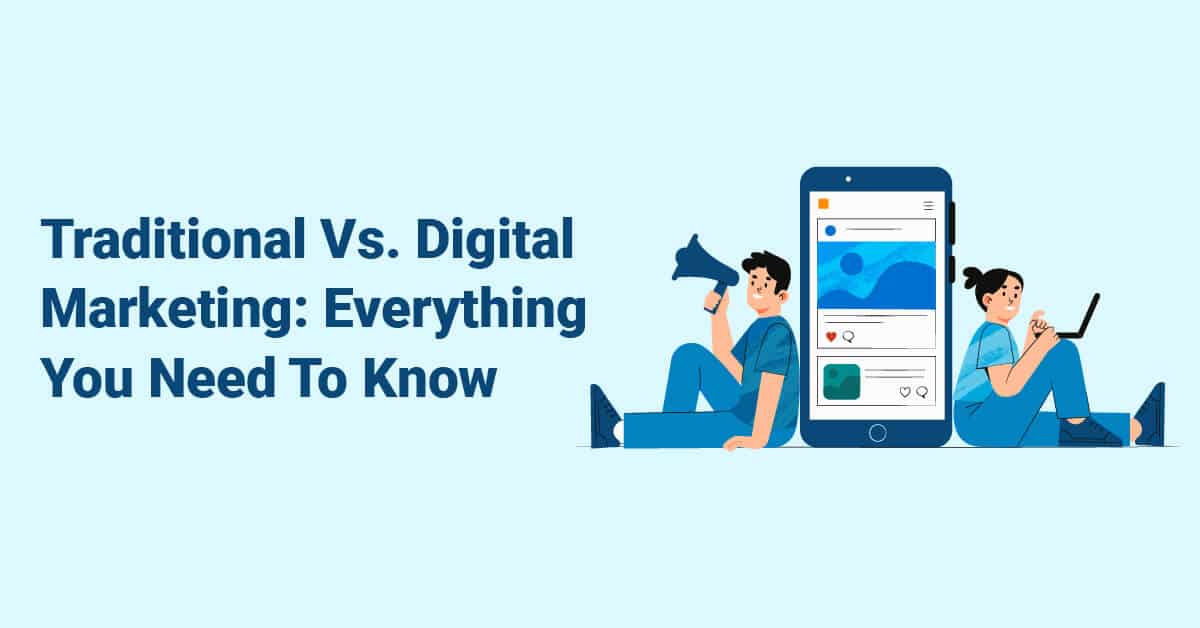Traditional Vs. Digital Marketing: Everything You Need To Know

Introduction

Marketing is vitally important for every business, from the multimillion dollar businesses, all the way down to start-up businesses, and even “mom and pop” shops and independent sellers. No matter whether you are at the top or bottom of the business world, having a marketing budget also requires having a marketing plan. Therefore, whatever your position, you have to ensure that you spend your marketing budget in the right places to really make the most of your money.
Part of creating a marketing plan is deciding if you want to use digital or traditional marketing for your business plan, and once you’ve chosen this, which of the areas in this marketing type is best suited to you and your business.
For most, reaching the ideal customer through the correct marketing system is not as easy as it looks, but it does make a massive difference. Therefore, by gaining knowledge on how these marketing types differ, you can change your business and your success.
That is why we are here.
Table of contents
What is the difference between traditional marketing and digital marketing

The primary difference between traditional and digital marketing is the medium in which your target audience will encounter your message. Traditional marketing targets traditional media, such as magazines, billboards, and broadcasting, whereas digital marketing targets digital media and the internet such as the use of websites, social media, and affiliate marketing.
For either of these marketing types, you need to think about your audience and your target demographic. Ask yourself questions such as; ‘What types of media and communications are these people most likely to use?’, and ‘will my audience be more likely to read newspapers or online news?’
An example of this would be the target demographic for first time homeowner’s insurance, versus the demographic for funeral planning. The first demographic is most likely to be younger, from ages 18 to 30, and this generation is more likely to get their information through digital media. However, the second demographic is more likely to be 50 or 60 plus, and while many of this age group will use digital media, they will most likely be drawn to traditional media.
The difference between traditional and digital marketing is the medium through which the audience receives the information, and in many cases it can also help you to narrow down the demographic that you target as well.
As an example, consider the scenario just mentioned above – if you were advertising for first time homeowners’ insurance, you may get less of a response using traditional marketing than if you were to use digital marketing. However, this is not always the case. Why? That’s where the next part comes into play.
Which type of marketing is better?
Now, we ask which is better. Strictly speaking, neither is better than the other. Many would argue digital marketing is better due to the influx of internet usage taking over physical mediums such as print.
Yet, with TV, Radio and more, there are still plenty of traditional mediums that still get plenty of attention.
Digital media marketing can be both extremely beneficial and a battleground. The digital marketing world can be a bit like fighting for your place, with so many businesses using it, the digital marketing world requires you to really stand out from the crowd to be heard.
Sometimes it can be very beneficial to a business to take certain marketing channels from digital and traditional, and use a bit of both, to gain the best of both worlds. However, which is better depends on what audience you are targeting, and how you use your advertisements.
The success of a marketing campaign is not only in the medium you chose, but also in the campaign itself, a colorful and exciting billboard that has good wording and perhaps a humorous slogan will get more attention than a bland, and dull online social media post.
Whether traditional or digital marketing is better is dependent on the business, the product, the target demographic, and how you utilize and create your marketing campaign.
There is no hard winner between the two.
Traditional marketing channels:
So, considering all this, what actually counts as a traditional marketing channel? Let’s have a look at the main mediums that fall into this category.
Outdoor (i.e. Billboards, bus/taxi wraps/ posters, etc.)
Outdoor advertising is one of the most popular forms of traditional marketing. Unlike some other forms of traditional marketing, this is one that is unlikely to be taken over by digital marketing any time soon. Billboards have been used for a very long time, and they are often found on the side of roads to catch your eye as you are traveling. This is very successful if you choose the right design that will stick in people’s minds.
Broadcasting (TV, Radio, etc.)
Next up is broadcasting. This is another form of traditional marketing unlikely to be taken over by digital any time soon. Advertising on TV shows is notorious for drawing attention. Consider the Super Bowl advertisements that get a great deal of attention, and do not forget how many toys are bought as a result of TV commercials on kids shows.
Print (Magazines, newspapers, etc.)
Magazines and newspapers have not yet been taken over by digital media, although the print industry has suffered as a result of this. Placing advertisements in magazines and newspapers can still be beneficial, however, it is very dependent on the audience and the quality of your advertisement.
Direct Mail (catalogs)
Direct mailing, such as catalogs, can work, although they are not as common as once before. Some stores online and offline still make a considerable amount of sales from this marketing method. This is often a method used once someone has made a purchase from a store, the store will then send regular catalogs to show their products to the previous customer. However, this is a method that can be utilized through leaflet deliveries as well.
Leaflet/ pamphlets are another form of this which is common, it is often used for takeout food chains. These can include discount codes, vouchers, and exclusive deals.
Telemarketing (phone, text, etc.)
This is a method that is used very often, and is probably the most disliked by consumers. Telemarketing can be a useful method of marketing, however, it does have a bad reputation.
Text based telemarketing is often used on previous customers and can increase sales. However, telemarketing, while having the potential to be lucrative, is often not successful, simply because many people quickly hang up, due to the many scammers placing telemarketing calls.
Window display and signs
Window displays and signs can also be very lucrative. Although they are not accepted everywhere, they have the potential to draw attention in public spaces. This type of marketing works well for some industries, but not always so well for others. The place in which these are places is also vital. Most often these will be placed in general stores, and public transport locations.
If you have your own shop, you can use this form of marketing to your advantage, using your window space to really showcase your products and services. Remember to offer uniqueness and a wow factor that makes you stand out from the crowd to get the most out of this type of marketing.
Digital marketing channels
Digital marketing is when you use the internet to your advantage in your marketing scheme, using electronics, mobile devices, social media, and so on. No matter what business you have, how big or small it is, or what your business does, you can always leverage digital marketing to your advantage.
Digital marketing has changed the way in which we promote our businesses and the way in which our customers shop. More and more of the business world is shifting online, and so, to avoid digital marketing completely would be unwise.
Social media
Everyone and everything is on social media; our politicians, chain restaurants, celebrities, banks, and so on. Being on social media is very advantageous and brings you closer to your customers. Using Facebook, Instagram, Twitter, and other social media, even newer ones such as TikTok can be really advantageous. They bring your customers closer to you, and you can engage with them on a more personal level, which can attract more business.
Website
Creating a website is not always going to draw customer attention, however, it is a fantastic way to interact with customers. It is a place where you can store all the information about you. Include information about your products and services, contact information, business hours. Also leave an area in which customers can communicate with you and leave reviews.
Video
Video is an enticing way to draw in customers. With the world moving so fast these days, people have a short attention span, and therefore short videos are a brilliant way to attract consumers. A consumer is more likely to be interested in your content and services if you release a 60-second video than if you produce a 3 paragraph written advertisement. Videos are also easier to take in, visual stimulation is the favored form of communication via media in modern day. And there is also so much you can do with it.
Videos can allow you to promote audience interaction. You can also share videos over multiple platforms, thus reaching a wider audience. You can publish a video on YouTube and share it to Facebook, Twitter, Instagram, your website, and reach a much greater audience than you would through a single channel.
Content marketing
Content marketing is a strategic approach that focuses on creation and the distribution of valuable, consistent, and relevant content to draw in a defined audience.
This is a set of strategies, techniques and tactics to fulfill goals for the company that will engage consumers. Things such as blogs, podcasts, video, and social media sites and transportation for relevant content.
Content marketing is not always easy, though, and finding the right way to use this can be a real trial and error process. However, content marketing is now used by 86% of businesses, if not more, today.
Affiliate marketing
Affiliate marketing is not all that different to content marketing, but it has one distinct difference. It is the process in which an affiliate will earn commission for marketing other companies products. If you have money in your budget, you can hire a professional to market your content, which can be time saving and also beneficial for you, as a professional will be able to tackle the marketing side of your business with more accuracy. They promote your product/ business, and then earn a piece of the profit from the sales made. Sales will then be tracked via affiliate links from website to website.
Inbound marketing
Inbound marketing is the simple process of helping potential customers to find you. It utilizes something known as ‘pull-marketing’, which includes content, blogs, events, SEO, and social media to craft brand awareness and attract the relevant customers to the business.
Email marketing
Email marketing straddles digital marketing and direct marketing. This is a process that uses email to promote your business and your products. It will make customers aware of your latest items or offers by including it in your marketing automation efforts. If you look through your email inbox, you are sure to find some of these from companies you frequent.
PPC
PPC means pay-per-click. It is an online advertising model in which an advertiser pays a publisher every time an advert link is ‘clicked’. This can also be known as ‘cost-per-click. It is often on offer by social networks as search engines, such as Google and Facebook, but also some seller platforms such as Amazon.
SEM
Search engine marketing (SEM) is used to increase the visibility of a website in the search engines result pages- think about google results. Although this once referred to organic search activities such as SEO as well as paid, it is almost exclusive to paid search advertising, this is tied in quite closely with PPC now.
Traditional marketing: Pros and Cons

Now that we are aware of what falls under the traditional marketing area, let’s consider what the pros and cons of this type of marketing are.
Pros
The things that are best about traditional marketing.
- It’s impactful
One of the best things about traditional marketing is that they are easy to understand. A visually bold billboard, or perhaps a striking and fun TV commercial are standard parts of our days, we are used to them, and we can often find them interesting if done right. They are also easy to digest and don’t involve any complexities.
- Its permanent
The permanency of traditional marketing, especially print, means that you can create one advertisement, and it will be there longer if it is traditionally marketed, especially in print. Many people will also collect things such as the New York Times,
- Its memorable
We are constantly consuming through technology, so it is no wonder that we so often forget the things we see online. For this reason, traditional marketing can prove to stick in our minds longer. Seeing something in real life is more likely to be remembered. A funny Super Bowl commercial is more likely to stay in your mind than a Facebook ad that you scrolled past in a millisecond.
Cons
While the above make traditional marketing sound amazing, it is not all sunshine and rainbows, nothing is perfect, and traditional marketing has its flaws.
- It’s expensive
For a new company, in its younger years, it is unlikely you will be able to afford a detailed spread in Vogue or The New York Times. A billboard is not cheap, and neither is a TV ad. Most forms of traditional marketing will set you back quite a bit of cash, and so this is one of the areas in which it falters. You usually need some level of success already to be able to afford these forms of marketing.
- It’s hard to measure
Digital marketing is so easy to measure, however traditional marketing lacks in this area. While you can get brand trackers, the information you get from this is lacking in comparison. You won’t get as much depth, and these trackers are nowhere near as intelligent as you would find in digital marketing.
- There is no direct interaction with your audience
Digital marketing, including social media use, invites you into a more direct relationship with your audience and your customers, making the interaction more personal. With traditional marketing means, you miss out on this, which means that you are usually pretty much in the dark about how your audience feels about your marketing style.
- It is difficult to receive feedback
Building on our last point. Since you lack the interaction with your customers, you also lack feedback from them. Feedback from your audience can help you to better understand what it is that they want from you, however, with no way to directly interact, you have no easy way to gather feedback. This creates a bit of a hole in your marketing scheme.
While some companies may not be focused on feedback, feedback can be one of the most useful tools when you are building your business. A consumer is on the outside looking in, and they may see things that you cannot see from your perspective.
Digital marketing: Pros and Cons

Digital marketing is focused in the online world, advertising and promoting your brand on the internet. It is an ever-growing world with many options and opportunities for new and old businesses. It, too, has good and bad factors that influence its use by businesses.
Pros
Digital marketing has a lot going for it. The internet has broadened our horizons and made the world closer together, so why wouldn’t it be a great business tool. These are some of the best things about using digital marketing.
- Direct engagement with the audience
Having the opportunity to directly engage with your audience offers you more opportunities to see what your consumers really think of your brand and your marketing strategy. This offers you the opportunity to get more feedback and build your brand. Social media also partakes in this, giving you the opportunity to see how much your content has been shared, liked, and how many positive comments it has, the more of this you see, the more you will know you are doing something right.
- Digital marketing strategies incur a much lower cost
Digital marketing is a lot cheaper than its counterpart. While affiliate marketing and PPC do cost, it is nowhere near as expensive as paying out for a billboard or a newspaper ad. You can even create free websites when you start up using programs such as WordPress, which you can monetize and eventually build into paid platforms.
- It can target world-wide audiences easily
While traditional marketing is more restrictive in its location, usually only staying within the local area, digital marketing opens you up to the whole world, making you and your content available from the highest stretches of Greenland to the most southern reaches of Argentina, and everywhere in between. You can market your content to consumers all over the world.
- It’s measurable
Where traditional marketing doesn’t have the best tools for measuring your campaigns, digital marketing offers depth. It helps you to better understand how your marketing is working, and lets you learn from your efforts so far.
Cons
Just like traditional marketing, digital marketing is not all sunshine and rainbows, and it has its downsides too.
- Can be potentially annoying to your audience
Digital marketing can be annoying in places, constant ads on Facebook, Instagram, and YouTube can be infuriating when you are just looking to stay up to date with the happenings in the world. Some also find it annoying how well ads are targeted, you might have spoken about something yesterday, and now you’re seeing ads for it? This is one of the bigger downsides, your consumers might find this clever targeting somewhat irritating.
- It is less permanent
Digital marketing does not have the permanency of traditional. Although whatever is put up on the internet is there forever, it is easily replaced and outdated in this ever-moving world. Social media ads, banners, promo emails and so on are fleeting and temporary. They are also intangible and are easily ignored, all someone needs to do is scroll past your advert, and it is gone.
- It constantly evolves
One thing that is both great and terrible about the digital marketing world is its constant evolution. Using digital marketing means staying up to date with the latest trends and habits of the digital world, and there is also a lot to learn about it. Channels require specialists, from using social media to search engines, if you want to really get the most out of this.
While using the internet is easy, and making social media posts is done in the snap of your fingers, maintaining a prominent enough social media and online presence to really have an impact, and to reap the success of your efforts, it does require a professional. It is also work seeking out professional assistance when it comes to digital marketing, to save you spending time researching the evolution of the field. A professional will have better knowledge about the growth of this area and be able to keep your content up to date with the latest online marketing trends.
Trade show marketing explained

Trade show marketing is another form of marketing that does not really fall into either of these categories. Since trade show marketing became a thing, companies from all over the place, in every industry, take advantage of the plethora of benefits that trade show marketing offers.
When you start out in trade show marketing, you need to define your goals and objectives clearly to make the most of the opportunity. What your aims are will guide you through every decision you make in the process. You are aiming to give trade show goers a reason to check you and your brand out. Standing out is the most important part of this, uniqueness brings attention.
What is trade show marketing?
Before we get into too much detail, let’s discuss what trade show marketing actually is. Have you ever experienced a ‘comic-con’? It’s like that, but for businesses to flaunt what they’ve got. It is basically an exhibition in which companies in specific industries showcase and demonstrate all their newest products and services. These events are usually only open to the people who register to attend, as well as company representatives, and members of the press.
The audience this brings facilitates meaningful conversations between companies, competitors, and consumers.
These events used to be viewed negatively, as endless booths, with folding tables and chairs, desperate salesmen, and cheap promotions. However, innovation in marketing strategies have become the bread and butter of these events. Trade shows in the present offer first glances at never-before-seen products and showcases. What was once desperation, has been replaced with a dash of glam as companies invest significantly in order to stun and amaze those attending with creative productions and promotions.
How to set up a trade show marketing campaign
If this sounds like something that you would like and that would be beneficial to your marketing strategy, then there is no harm in trying it out and testing the waters to see if this can become a regular part of how you market your brand.
Setting up your trade show campaign is not difficult, and all you need is organization and determination.
Start off your preparation with some simple planning, plan ahead and think about how you will wow your audience at the event, what you will showcase and how you will do it. Don’t be afraid to take up some education in presentation, you want to wow the audience with yourself as well as your brand, an enthusiastic and confident sales person makes all the difference. Don’t be afraid to budget, arrange a timeframe, and conduct research into your audience.
Preparation is a key aspect of all this, not only do you need to plan, but also prepare. Understand what you will do, be organized and make sure everything is ready for the day. Make sure you are well-rested and have a positive outlook on the event the day before, this can make all the difference. Advertising your presence at the event will also help you a great deal, you want your current audience to attend as well as new people.
While you are presenting yourself at the event be sure to make a good impression, ensure your booth is enticing and interesting, use different mediums, videos, audio, banners, and perhaps even audience integration activities to draw people in, the more interesting the booth, the more attention you will get.
Similarly, build a warm relationship with the people there, even if you are not typically a people person, you are today. No one wants to invest in a business if the salesperson seems unfriendly or neglectful. Sell warm, smile, and be approachable. You can also host a supplemental event to give you more opportunities to speak with people outside the trade show environment. Keep your demonstration strong but don’t be forceful or annoying, no one wants to give attention to that guy who comes off like a used car salesman.
Finally, after the event, be sure to stay in touch, work on any leads from the event, develop multiple-touch marketing campaigns, and follow people on social media (LinkedIn is good for this). And do not forget, follow up on any leads as soon as possible, snatch them up before a competitor does.
Summary

There is no way to say exactly which type of marketing is the best, different things work for different people and businesses, and different demographics will be targeted best through different mediums.
Understanding who you are targeting, and where they are most likely to engage with your content, is your first step. Digital marketing and Traditional marketing both have pros and cons that make these both worth engaging in. Trade shows are also useful for many businesses. For start-up businesses, digital marketing is the easiest place to start due to low costs and easy audience access to build your consumer base. After this, engaging in different marketing strategies will help your business grow and branch out.
